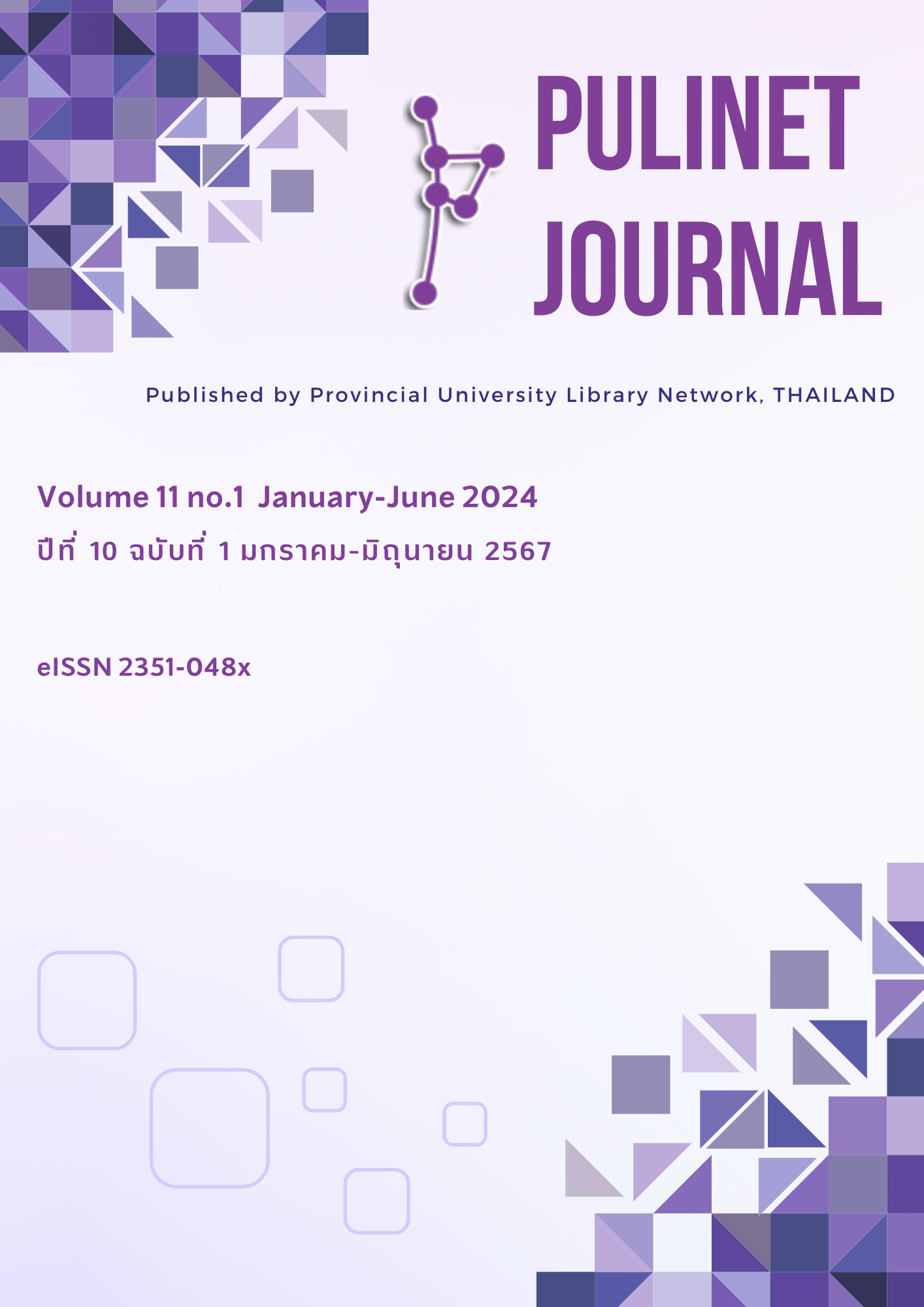การพัฒนาการให้บริการในรูปแบบห้องสมุดมีชีวิต: กรณีศึกษา สถาบันทรัพยากรการเรียนรู้และเทคโนโลยีดิจิทัล มหาวิทยาลัยทักษิณ
Main Article Content
บทคัดย่อ
การพัฒนาการให้บริการในรูปแบบห้องสมุดมีชีวิต: กรณีศึกษา สถาบันทรัพยากรการเรียนรู้และเทคโนโลยีดิจิทัล มหาวิทยาลัยทักษิณ มีวัตถุประสงค์ เพื่อพัฒนาการให้บริการในรูปแบบห้องสมุดมีชีวิต โดยใช้กระบวนการคิดเชิงออกแบบ ซึ่งมีขั้นตอน ดังนี้ (1) การทำความเข้าใจปัญหา (Empathize) ศึกษาปัญหาจากรายงานการวิจัยฯ, การสนทนากลุ่ม และการศึกษาวิเคราะห์หน่วยงานความร่วมมือ (2) การวิเคราะห์และสังเคราะห์ปัญหา (Define) เพื่อจำแนก Pain Point และ Gain Point (3) การระดมความคิด (Ideate) ร่วมกันกำหนดพื้นที่ให้บริการและกิจกรรมการเรียนรู้ (4) การสร้างต้นแบบ (Prototype) ร่างแผนพัฒนาบริการและกิจกรรมการเรียนรู้ (5) การลงมือทำและการทดสอบ (Test) จัดกิจกรรมตามแผนพัฒนาบริการและกิจกรรมการเรียนรู้ และถอดบทเรียนแลกเปลี่ยนเรียนรู้ เพื่อปรับปรุงการให้บริการและกิจกรรม
ผลการดำเนินการ พบว่า จำนวนผู้เข้าใช้บริการห้องสมุดเพิ่มมากขึ้น เมื่อเปรียบเทียบ 2 ปีการศึกษา เนื่องจากมีการจัดการเรียนการสอนกิจกรรมชุมนุมที่ห้องสมุด ร่วมกับหน่วยงานความร่วมมือ คือ โรงเรียนสาธิตมหาวิทยาลัยทักษิณ และ โครงการห้องเรียนวิทยาศาสตร์ในโรงเรียนป่าพะยอมพิทยาคม โดยการกำกับดูแลของมหาวิทยาลัยทักษิณ โดยมีบรรณารักษ์เป็นผู้สอนและอำนวยความสะดวก และมีการจัดกิจกรรมตามแผนพัฒนาบริการและกิจกรรมที่สอดคล้องกับพื้นที่ให้บริการในรูปแบบห้องสมุดมีชีวิต 6 ประเภท ซึ่งผลการประเมินความพึงพอใจของผู้เข้าร่วมกิจกรรมตามแผนฯ อยู่ในระดับดีมาก
Article Details

อนุญาตภายใต้เงื่อนไข Creative Commons Attribution-NonCommercial-NoDerivatives 4.0 International License.
เอกสารอ้างอิง
ชุติมา สัจจานันท์, กาญจนา ใจกว้าง และ มาลี ล้ำสกุล. (2554). รายงานการวิจัย การสังเคราะห์องค์ความรู้ห้องสมุดมีชีวิตรูปแบบอุทยานการเรียนรู้. สำนักงานอุทยานการเรียนรู้.
ปราณี อัศวภูษิตกุล. (2561). พื้นที่การทำงานร่วมกันของห้องสมุด. วารสารห้องสมุด, 62(1), 1-15.
ไปรมา อิศรเสนา ณ อยุธยา และ ชูจิต ตรีรัตนพันธ์. (2560). การคิดเชิงออกแบบ: เรียนรู้ด้วยการลงมือทำ. ศูนย์สร้างสรรค์การออกแบบ (TCDC). http://resource.tcdc.or.th/ebook/Design.Thingking.Learning.by.Doing.pdf
มหาวิทยาลัยทักษิณ. ฝ่ายแผนงาน. (2566). แผนกลยุทธ์มหาวิทยาลัยทักษิณ ระยะ 5 ปี (พ.ศ. 2566-2570). มหาวิทยาลัยทักษิณ.
สำนักหอสมุด. (2566). แผนยุทธศาสตร์การพัฒนาสำนักหอสมุด มหาวิทยาลัยทักษิณ ระยะ 5 ปี (พ.ศ. 2566-2570). มหาวิทยาลัยทักษิณ.
รุจโรจน์ แก้วอุไร และ ชโรชีนีย์ ชัยมินทร์. (2562). พื้นที่การเรียนรู้สำหรับผู้เรียนยุคดิจิทัลในห้องสมุดสถาบันอุดมศึกษา. วารสารศึกษาศาสตร์ มหาวิทยาลัยนเรศวร, 21(4), 366-378.
วีรยา พืชธัญญากิจ. (2562). แนวทางการพัฒนา Coworking Space บริเวณสถาบันการศึกษา กรณีศึกษา บริเวณสยามสแควร์และสามย่าน. สาระศาสตร์, 2(2), 176-188.
สุนิษา ขันนุ้ย, ขวัญชนก วิริยะกุลโอภาส, ผกาทิพย์ ชูชาติ, บุญญฤทธิ์ คงลำพูน, ธมลวรรณ ขุนไพชิต, เนาวลักษณ์ แสงสนิท, นพดล ชัยศิริ และ ปิติมา แก้วเขียว. (2559). รายงานการวิจัย ปัจจัยที่มีผลต่อการไม่ใช้ห้องสมุด ของนิสิตและบุคลากร และแนวทางส่งเสริม: กรณีศึกษา สำนักหอสมุด มหาวิทยาลัยทักษิณ. มหาวิทยาลัยทักษิณ.
D.school. (2023, February 9). Standford D.school Design Thinking Process. http://dschool.stanford.edu
Miroslavov, Miroslav. (2023, February7 ). 4 Pillars of Successful Coworking Spaces. Officernd. https://officernd.com/blog/4-pillars-of-successful-coworking-spaces/
Watson, L. (2013). Better library and learning space: Project, trends and ideas. FACET Publishing.


